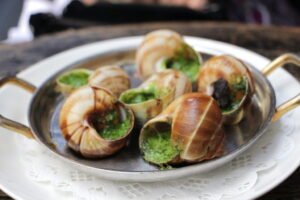French food is known globally for its refinement and deliciousness. Among its many culinary options, escargot and foie gras are among the most intriguing and expensive. These dishes not only demonstrate the refinement of French cuisine, but also provide insight into the country’s culinary history and regional diversity. This blog post goes deep into the world of these French delicacies, looking at their origins, preparation, and the special position they occupy in the hearts of foodies everywhere.
The Elegant Escargot
Escargot, a delicacy made from cooked land snails, is often regarded as the pinnacle of French gourmet cuisine. Snails have been around since prehistoric times, but the Romans were the first to consider them a delicacy. Escargot first gained popularity in France in the 17th century and has since become a mainstay of French cuisine, particularly during the holiday season.
The most popular snail species for escargot is Helix pomatia, generally known as the Roman snail. These snails are often cooked with garlic butter, parsley, and a splash of white wine, resulting in a rich but delicately flavored dish. The snails are served in their shells, with a unique set of tongs and a slender fork made just for this purpose.
Escargot dining is about the experience as much as the taste. The procedure of extracting the snail from its shell and relishing the buttery, herb-infused sauce adds a tactile delight to the overall gourmet experience. Escargot is more than simply food; it’s an art form that honors French culinary traditions that many people around the world have come to love.
The Controversial Foie Gras
Foie gras, sometimes known as ‘fat liver,’ is another French delicacy with a rich, buttery flavor and silky texture. It is produced from the liver of a carefully fattened duck or goose, a method that originated in ancient Egypt but was refined in France. Despite the controversy surrounding the fattening procedure, foie gras is nevertheless a popular ingredient in French haute cuisine.
Foie gras is meticulously prepared. After being cleaned and deveined, the livers are seasoned with salt, pepper, and occasionally a mixture of spices like allspice or nutmeg. The liver can be cooked in a number of methods, such as baking, searing, or poaching, but it’s most commonly made into a terrine or pâté by slowly cooking it in a water bath to give it a distinctively creamy texture.
Traditionally, foie gras is served with a sweet and tart side dish that balances its richness, like onion confit or fig jam. It is also frequently served with a crisp, slightly acidic drink, such as Champagne or a dry white wine, which highlights its opulent flavor and counterbalances its dense texture.
Regional Variations and Modern Adaptations
Particular regions of France are home to both foie gras and escargot. Famous for its escargot, sometimes referred to as “Escargots de Bourgogne,” Burgundy is recognized as the epicenter of foie gras manufacturing, with the Gascony region bearing this title. The variety of French cuisine is enhanced by the unique local flavors and customs that each region contributes to these recipes.
Modern chefs have been experimenting with these age-old treats in recent years, combining them into creative meals that broaden and test the palette. Escargot has been used as a pizza topping, in risottos, and in puff pastries. In the meantime, foie gras has proven its adaptability and continuing appeal by making an appearance in burgers, sushi, and a rich steak sauce.
Conclusion
More than merely delicacies, escargot and foie gras are cultural icons that capture the essence of French cooking’s heritage, creativity, and history. They might not be to everyone’s taste, but there is no denying their influence on the food industry. These treats provide a wonderful flavor of France’s rich culinary history to those who enjoy them, demonstrating the ingenuity and passion that characterize French cooking. Discovering these classic recipes allows us to connect with a timeless culinary legacy that captivates and inspires foodies all around the world in addition to indulging in their distinctive flavors.
Also Read: The Art of Moderation: Ayurveda’s Take on Sweets After a Meal



